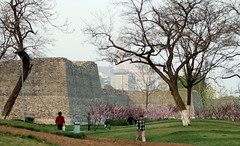A new thrill for you masochistic travelers out there: the tourist buses of Myanmar! After a wonderful sleepless 16-hour bounce-a-thon, I got off the bus at Nyuang-U, the backpacker-zone of Bagan at 4am. A decent room at the InnWa guest house was soon booked, a small breakfast quickly eaten, and a horse-cart hired for the entire day.
My trusty driver took me around to nearly two dozen major pagodas and temples across the north and south plains, ending with a picturesque sunset at a small unnamed 2-story temple on the south plain. I managed to stay awake long enough to sample some of Bagan’s regional tourist-specialty-food: pizza! (not bad, actually) and then slept like a sunburned baby for 12 hours.
The scene in Bagan is very similar to that in Angkor, Cambodia: its hot, dusty, full of tourists and home to some truly amazing ancient temples. Most of the structures in Bagan are about 1,000 years old although new pagodas and temples are still being built to this day - one key difference between Bagan and Angkor. Since Bagan continues to be an “active” religious site, the traditional methods of constructing and maintaining the temples have not been lost. Thanks to some help from UNESCO and a lot of tourist-industry dollars, many of the temples around are in great shape.
I rented a bicycle the next day and lazily pedaled around, revisiting some temples and checking out new ones. Bagan has over 4,400 temples and pagodas - the largest and most spectacular of them are frequented by a steady stream of tourists but there are literally thousands left that rarely see a visitor. Most of these less popular sites stay locked throughout the year, so to get inside you must locate the “keymaster,” which often turns into an adventure in itself. I made a point of visiting as many smaller “neglected” temples as possible.
In a book about Myanma art and architecture that I had recently finished reading (a gift from Pui), I learned about the legend of the “16 dreams of King Kosala.” It describes the horrible visions of a Burmese king which he had interpreted to predict the downfall of his empire sometime during the 12th century. I also learned that a mural depicting these visions can be found somewhere in or near Bagan. As I explored the temples, I asked around among the keymasters and souvenir vendors. After many tries, I learned that such a set of paintings exist in an unnamed temple near Salay, a small town about 3 hours’ drive from Bagan.
I was determined to get there. Salay is not too frequently visited by tourists, although it has a set of attractions including some more Bagan-era pagodas, a large active monastery and a museum. The only way for foreigners to (easily) get there is by taxi, and the best price I could find after heavy searching was $25. I knew that it would be an expensive day, but I was on a mission…
I told the driver that I wanted to visit temple #99 which is about 7km past Salay. He gave a groan and refused, saying that the roads are no good past Salay. Not to be deterred so easily, I got help from my guest house and phoned up a monastery near the temple and asked them about the road. “Just fine,” they said. With some gentle coaxing I got the driver to sign on to the mission under the condition that he be allowed to take along his two sisters.
He piloted his taxi like a cruise missile along the narrow rocky roads until we arrived in Salay. Some locals pointed us to the monastery I had phoned earlier, and I walked in to ask about the elusive temple #99. I asked the first guy I saw, and he turned around and asked someone who in turn asked someone, etc etc etc. By them time my “guide” approached me with the keys to number 99, he was flanked with 7 smiling friends. Each of them reached out to me with an open hand.
“OK You can pay me and I take you temple please,” the keymaster said.
“Great, how much do you want?”
“He is middlemen,” he answered, sweeping a finger in front of all 7 friends. They all laughed.
“Yes, middlemen. What does that mean?”
“Him 50 kyat, him 100 kyat, him 150 kyat, him 200 kyat, him 250 kyat, him 300 kyat, him 350 kyat. Middlemen, middlemen, understand?”
I ended up paying a total of 2,000 kyat (about $1.30) to be escorted about 2km down a dusty trail to the temple.
I expected it to be small and full of bats. It was. But I also expected a lot more of the paintings. I’ll post the photos shortly so you can share my disappointment. For now I’ll just say I have no idea how anyone can see anything in the tiny black and white blobs that I found on those walls. Oh well. As they say, its the journey.
I spent one more day in Bagan, caught another spectacular sunset and then decided to head east, back into southern Shan state to Kalaw for some trekking.







